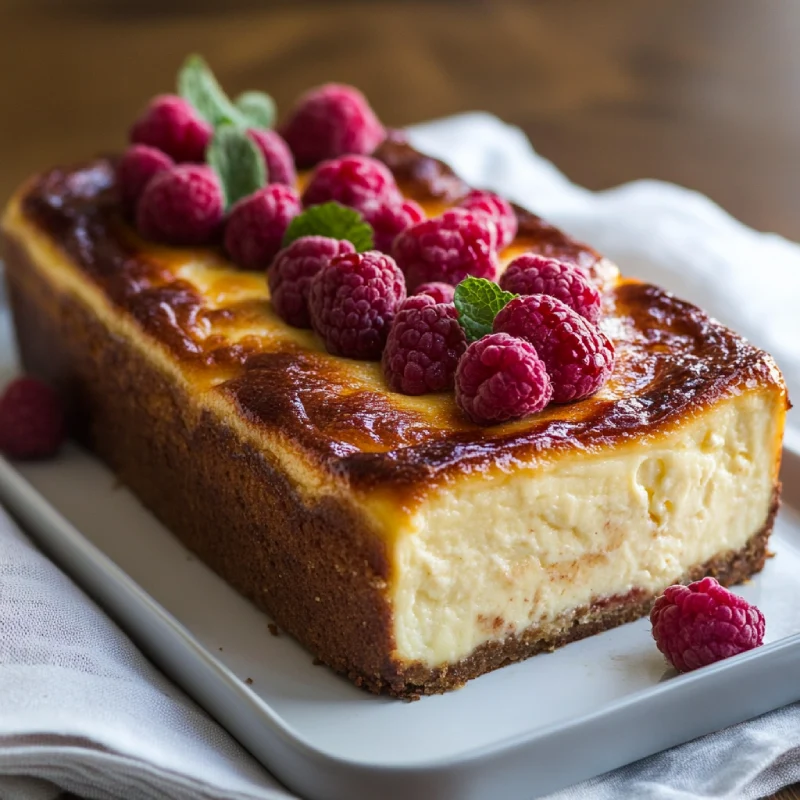Introduction and Basics
Introduction to Basque Cheesecake (200 words)
Basque Cheesecake is renowned for its rustic, less formal appearance and its deeply caramelized exterior, which contrasts with a creamy, rich interior. Originating from the Basque Country in Spain, specifically from a bar in San Sebastián known as La Viña, this dessert has gained international fame for its delicious simplicity and unique texture. Unlike the classic cheesecake, the Basque version is baked at a high temperature which results in its characteristic burnt exterior. This method not only simplifies the baking process by eliminating the need for a water bath but also intensifies the flavors.
The adaptation of this recipe to a loaf pan format allows for smaller servings, making it ideal for personal indulgence or small family gatherings. This variation maintains all the beloved features of the traditional round Basque cheesecake but in a more manageable size. For a deeper exploration of its origins and culinary significance, culinary enthusiasts can delve into resources that discuss the rich cultural tapestry of Basque cuisine here.
Why Use a Loaf Pan? (200 words)
Using a loaf pan for baking Basque cheesecake offers several benefits over traditional round springform pans:
- Portion Control: The rectangular shape of the loaf pan makes it easier to slice the cheesecake into uniform portions, ideal for smaller households or for those who prefer a more controlled serving size.
- Even Cooking: Loaf pans often result in more even cooking and heat distribution, particularly beneficial for the custard-like center characteristic of Basque cheesecake.
- Presentation: The loaf shape provides a modern twist on presentation, making it a unique addition to any dessert table.
Moreover, the adaptation of loaf pans for this recipe does not compromise the creamy texture and caramelized top that Basque cheesecakes are known for, while also ensuring that every slice is as aesthetically pleasing as it is delicious.
By choosing a loaf pan, bakers can enjoy the traditional taste of Basque cheesecake with added convenience and style, ensuring that this beloved dessert continues to evolve while respecting its culinary roots.
Detailed Recipe Instructions
Ingredients List (150 words)
For a loaf pan Basque cheesecake, you’ll need the following ingredients:
- Cream Cheese: Typically, about 400 grams, at room temperature for smooth mixing.
- Sugar: Roughly 150 grams to sweeten the mixture.
- Heavy Cream: Approximately 200 ml, which adds richness.
- Eggs: 3 large eggs, which help to set the cheesecake.
- Flour: Around 2 tablespoons to stabilize the mixture.
- Salt: A pinch to enhance the flavors.
- Vanilla Extract: A teaspoon for a hint of vanilla.
These ingredients combine to create a decadent, creamy dessert with a beautifully burnt exterior. For specific measurements and additional optional ingredients like lemon zest or cinnamon for flavoring, culinary resources like Serious Eats provide excellent guidance.
Step-by-Step Cooking Guide (500 words)
- Preparation:
- Start by lining your loaf pan with parchment paper, leaving enough overhang on the sides to easily remove the cheesecake after baking.
- Preheat your oven to a high temperature, around 220°C (430°F), to ensure a well-caramelized top.
- Mixing the Batter:
- In a large bowl, beat the cream cheese until smooth and creamy.
- Gradually add sugar, and continue beating until the mixture is completely smooth and free from lumps.
- Incorporate the eggs one at a time, fully blending each into the mixture before adding the next.
- Mix in the heavy cream, vanilla extract, and a pinch of salt, ensuring everything is well combined.
- Sift the flour into the batter to avoid clumps and mix until just combined.
- Baking:
- Pour the batter into the prepared loaf pan.
- Place in the preheated oven and bake for around 35-40 minutes. The high heat will help achieve the iconic burnt exterior while keeping the center slightly jiggly.
- Cooling and Serving:
- Allow the cheesecake to cool in the pan before removing it. This step is crucial as it continues to set while cooling.
- Refrigerate for a few hours to fully set the cheesecake, making it easier to slice.
- Tips for Perfection:
- Avoid overmixing the batter after adding flour to keep the cheesecake tender.
- Monitor the cheesecake closely towards the end of baking to achieve the perfect level of caramelization without burning.
Variations and Serving
Recipe Variations (300 words)
Experimenting with flavors and accommodating dietary restrictions can transform the classic Loaf Pan Basque Cheesecake into a dessert that everyone can enjoy:
- Flavor Additions:
- Enhance the basic recipe by incorporating aromatics such as vanilla extract or lemon zest to add depth to the cheesecake’s flavor profile.
- For a more nuanced taste, consider blending in spices like cinnamon or nutmeg, which complement the creamy texture.
- Dietary Adaptations:
- For a gluten-free version, substitute the traditional flour with a gluten-free alternative like almond flour or a commercial gluten-free blend that won’t alter the texture significantly.
- To make the cheesecake sugar-free, replace regular sugar with a granulated sugar substitute that measures like sugar. Ensure it is heat-stable to withstand the high baking temperatures without losing sweetness.
Serving Suggestions (200 words)
Properly presenting and pairing the Basque cheesecake can enhance the dining experience:
- Presentation:
- Slice the cheesecake once it is completely cooled and set, ensuring clean cuts by using a sharp, warm knife cleaned between slices.
- Garnish with a dusting of powdered sugar or a drizzle of caramel sauce for an elegant finish.
- Pairing Recommendations:
- Complement the rich taste of the cheesecake with a cup of strong espresso or a glass of sweet dessert wine like Moscato or Port.
- For a refreshing contrast, pair it with a citrus-based beverage or a scoop of lemon sorbet on the side.
Frequently Asked Questions
Ingredient Substitutions, Baking Temperatures, and Troubleshooting
- Can I substitute cream cheese with another ingredient in Basque cheesecake?
- While traditional Basque cheesecake uses cream cheese, you can use mascarpone for a richer texture or a blend of cream cheese and ricotta for a lighter version. Ensure the total weight remains the same for consistent results.
- What is the ideal baking temperature for a loaf pan Basque cheesecake?
- Basque cheesecake is typically baked at a high temperature to achieve its characteristic burnt exterior. For a loaf pan, baking at 220°C (428°F) is recommended to ensure the top caramelizes properly without overcooking the center.
- How can I prevent cracks in my Basque cheesecake?
- Cracks in Basque cheesecake can be minimized by:
- Ensuring all ingredients are at room temperature before mixing to achieve a smoother batter.
- Avoiding overmixing the batter, as this can incorporate too much air and lead to puffing and cracking during baking.
- Baking in a water bath can help, but it’s not traditionally used for Basque cheesecake due to its burnt top.
- Cracks in Basque cheesecake can be minimized by:
- My cheesecake is cooking unevenly. What can I do?
- If your cheesecake is cooking unevenly, consider rotating the pan halfway through the baking time to promote even cooking. Also, check your oven’s calibration to ensure it is heating correctly.
- What are some tips for ensuring even cooking?
- To ensure even cooking:
- Use an oven thermometer to verify your oven’s temperature.
- Place the baking rack in the middle of the oven to allow for optimal air circulation.
- Avoid opening the oven door frequently as this can lead to temperature fluctuations.
- To ensure even cooking:
Conclusion
Creating a Loaf Pan Basque Cheesecake offers a delightful twist on the traditional Basque dessert, allowing bakers to enjoy its rich, creamy texture and burnt exterior in a more manageable size. Here are the key takeaways from our guide:
- Versatility: Adapting the Basque cheesecake to a loaf pan format provides flexibility in portioning and serving, making it suitable for smaller gatherings without compromising on taste.
- Customization: The recipe’s adaptability with various flavor enhancements and dietary adjustments ensures that everyone can enjoy this unique dessert, regardless of dietary preferences.
- Baking Mastery: Through detailed instructions and troubleshooting tips, bakers at any skill level can achieve the perfect caramelized top and avoid common issues like cracking or uneven baking.
Whether you’re a novice baker or a seasoned chef, mastering the Basque cheesecake in a loaf pan format is a rewarding endeavor that combines traditional techniques with modern culinary creativity.

